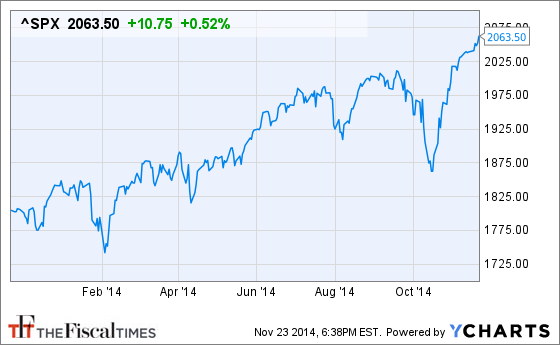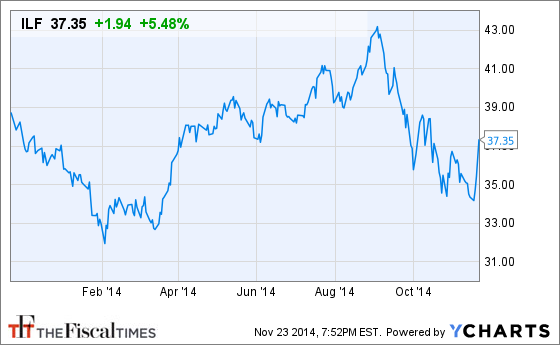Stocks ended last week at new record highs and the rally looks unstoppable. The S&P 500 is on the verge of setting a new record for short-term consistency, having closed above its five-day moving average for the 26th consecutive day on Friday. The best all-time streak was 27 straight days, set in 1986.
Back on October 16, one day after the market bottomed, I wrote that a rebound rally was in order based on the ferocity of the decline suffered in the first half of the month. I also warned that for investors still in the market, "this rebound could be the last opportunity to exit positions ahead of a more protracted decline should the global economic data continue to deteriorate."
Related: Investors Thankful for the Market’s Recent Strength
As they say, no one rings a bell at the top, but Friday's surge looks like a bull-trap blow-off move. If so, now's the time to get out. I mentioned a number of reasons in a recent column, including the tightening bias at the Federal Reserve, which remains on track to raise interest rates in mid-2015, and even noted in its October meeting minutes that policymakers are worried about coddling investors by talking up the potential for new stimulus whenever the market suffers a swoon.
But there are other factors weighing on my outlook. For one, breadth remains disappointing. The intra-day TICK indicator — which measures how many NYSE stocks on net are moving higher at any given time — topped out at just 500 early in the session on Friday and then languished. Medium-term measures of breadth have been weak as well, with just 73.6 percent of the S&P 500 in uptrends (despite the surge to a new record high), vs. the 76.2 percent level reached in September and the 84.6 percent level reached in July.
Also, I'm seeing robust buying of traditionally defensive assets, such as volatility via the CBOE Volatility Index (VIX), gold, and Treasury bonds. That's a sign some are preparing for a quick reversal from these levels (and, perhaps, also reacting to the specter of both a slowdown in the U.S. economy and the potential for a nasty political blood feud over the budget and debt ceiling).
Related: Why America Voted Against Obama’s Economy
Moreover, conditions have simply been too good for too long. Not only has the S&P 500 been above its five-day moving average for an extended period but it is working on its 29th consecutive month above its five-month moving average. According to Jason Goepfert at Sundial Capital Research, this combination of both long-term and short-term consistency has never been seen before. "Not even close," in his words.
The longest previous long-term consistency streak ended at 24 months back in September 1955. Next to that was a 22-month streak ending in April 1965, and two 18-month streaks ending in 1959 and 1996.
A combination of long-term and short-term consistency of the type we're seeing now has only been seen three other times in market history, in September 1954, September 1955, and January 1965. All three were far less long-lived than the situation we've got now.
The simple truth is this: The stock market rally just can't get much better than it is now. The very definition of successful investing — buying low and selling high — necessitates getting out when the getting is good. Now's as good a time as any, especially with the big potential catalysts that await in early 2015.
Related: How Rising Interest Rates Could Affect Your Portfolio
In response, I've been recommending that my newsletter subscribers increase their cash allocations while also moving into defensive positions poised to move higher, such as the leveraged ProShares Ultra Silver (AGQ). Silver futures are enjoying their first uptrend since June as the intense selling pressure seen since July looks set to relent.
I think precious metals can have it both ways, enjoying a rebound on a reacceleration in the global economy (which would boost inflationary pressures) or a return of fear and panic (especially if driven by a fiscal fight between Congress and the White House).
If, on the other hand, you think the uptrend can continue to power higher then consider the fresh breakouts underway in emerging market stocks following the interest rate cut out of the People's Bank of China. The iShares Emerging Markets (EEM) is blasting up and out of a two-month consolidation range that followed September's decline. Latin America in particular looks strong, with the Latin America 40 iShares (ILF) challenging its 200-day moving average.
While U.S. stocks have arguably never had it better than they do now, emerging market stocks are trading at levels first hit in 2007. A balanced approach would see the trimming of overextended U.S. equity positions in favor of cash, precious metals, Treasury bonds, and a sprinkling of emerging market equities exposure.
Top Reads from The Fiscal Times:
- Why the Bull Market Is on Borrowed Time
- Investors Say ‘Nyet’ to Russian Bond Sales
- Why Wall Street Breeds So Many Bad Apples




